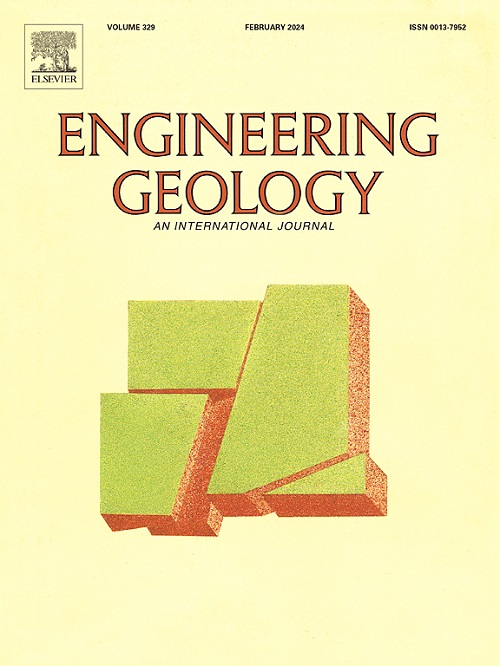Improving soil liquefaction prediction: A sophisticated ensemble classifier utilizing enhanced correlation features and a metaheuristic ant colony optimization approach
IF 6.9
1区 工程技术
Q1 ENGINEERING, GEOLOGICAL
引用次数: 0
Abstract
Soil liquefaction is a major contributor to earthquake damage. Evaluating the potential for liquefaction by conventional experimental or empirical methods is both time-intensive and laborious. Utilizing a machine learning model capable of precisely forecasting liquefaction potential might diminish the time, effort, and expenses involved. This research introduces an innovative predictive model created in three phases. Initially, correlation analysis determines essential elements affecting liquefaction. Secondly, predictions are produced using Convolutional Neural Networks (CNN) and Deep Belief Networks (DBN), verified by K-fold cross-validation to guarantee resilience. Third, Ant Colony Optimization (ACO) improves outcomes by increasing convergence efficiency and circumventing local minima. The suggested EC + ACO model substantially surpassed leading approaches, such as SVM-GWO, RF-GWO, and Ensemble Classifier-GA, attaining a very low False Negative Rate (FNR) of 2.00 % when trained on 90 % of the data. A thorough performance evaluation shown that the model achieved a cost value of 1.133 % by the 40th iteration, exceeding the performance of other models such SVM-GWO (1.412 %), RF-GWO (1.305 %), and Biogeography Optimized-Based ANFIS (1.7439 %). The model exhibited significant improvements in convergence behavior, with a steady decline in cost values, especially between the 20th and 50th iterations. Additional validation using empirical data from the Tohoku-oki, Great East Japan earthquake substantiated the EC + ACO model's enhanced accuracy and dependability in mirroring observed results. These findings underscore the model's resilience and efficacy, providing a dependable method for forecasting soil liquefaction and mitigating its seismic effects.
改进土壤液化预测:利用增强相关特征和元启发式蚁群优化方法的复杂集成分类器
土壤液化是造成地震破坏的主要原因。用传统的实验或经验方法评估液化潜力既费时又费力。利用能够精确预测液化潜力的机器学习模型可能会减少所涉及的时间、精力和费用。本研究介绍了一个分三个阶段创建的创新预测模型。首先,通过相关分析确定影响液化的基本要素。其次,使用卷积神经网络(CNN)和深度信念网络(DBN)进行预测,并通过K-fold交叉验证进行验证,以保证弹性。第三,蚁群算法通过提高收敛效率和规避局部极小值来改善结果。所建议的EC + ACO模型大大超过了领先的方法,如SVM-GWO, RF-GWO和Ensemble Classifier-GA,当对90%的数据进行训练时,获得了非常低的假阴性率(FNR),为2.00 %。经过全面的性能评估,该模型在第40次迭代时达到了1.133%的成本值,超过了SVM-GWO(1.412%)、RF-GWO(1.305%)和Biogeography optimizedbased ANFIS(1.7439%)等其他模型的性能。该模型在收敛行为方面表现出显著的改进,成本值稳步下降,特别是在第20和第50次迭代之间。另外,利用东日本东北大地震的经验数据验证了EC + ACO模型在反映观测结果方面的准确性和可靠性。这些发现强调了该模型的弹性和有效性,为预测土壤液化和减轻其地震影响提供了可靠的方法。
本文章由计算机程序翻译,如有差异,请以英文原文为准。
求助全文
约1分钟内获得全文
求助全文
来源期刊

Engineering Geology
地学-地球科学综合
CiteScore
13.70
自引率
12.20%
发文量
327
审稿时长
5.6 months
期刊介绍:
Engineering Geology, an international interdisciplinary journal, serves as a bridge between earth sciences and engineering, focusing on geological and geotechnical engineering. It welcomes studies with relevance to engineering, environmental concerns, and safety, catering to engineering geologists with backgrounds in geology or civil/mining engineering. Topics include applied geomorphology, structural geology, geophysics, geochemistry, environmental geology, hydrogeology, land use planning, natural hazards, remote sensing, soil and rock mechanics, and applied geotechnical engineering. The journal provides a platform for research at the intersection of geology and engineering disciplines.
 求助内容:
求助内容: 应助结果提醒方式:
应助结果提醒方式:


